Understanding the population of Mexican unauthorized immigrants in the U.S. is crucial for grasping the complexities of immigration. Gaymexico.net is here to provide up-to-date, comprehensive information on this topic, offering insights into the demographics, trends, and related socio-economic factors. Discover the latest statistics, regional distributions, and the evolving landscape of Mexican immigration in the United States with us, as well as resources for LGBTQ+ individuals in Mexico.
1. What Is The Current Estimate Of Unauthorized Immigrants From Mexico In The US?
In 2022, there were approximately 4.0 million unauthorized immigrants from Mexico living in the United States, marking the lowest number since the 1990s. This figure represents a significant decrease from the peak of 6.9 million in 2007, according to the Pew Research Center. This decline reflects broader changes in migration patterns, including decreased migration from Mexico to the U.S., some Mexican immigrants returning to Mexico, and expanded opportunities for legal immigration, particularly for temporary agricultural workers.
2. How Has The Number Of Unauthorized Immigrants From Mexico Changed Over Time?
The number of unauthorized immigrants from Mexico in the U.S. has seen significant fluctuations over the past few decades. The population peaked at 6.9 million in 2007 but has since decreased to 4.0 million in 2022. This reduction can be attributed to several factors, including:
- Decreased Migration: There has been an overall decline in the number of Mexicans migrating to the U.S.
- Return Migration: Some Mexican immigrants have returned to Mexico.
- Legal Immigration Opportunities: Expanded opportunities for legal immigration, especially for temporary agricultural workers, have provided alternative pathways for Mexicans seeking to work in the U.S.
3. What Factors Contribute To The Fluctuation In The Number Of Unauthorized Immigrants From Mexico?
Several factors contribute to the fluctuations in the number of unauthorized immigrants from Mexico in the U.S.:
Economic Conditions
Economic downturns in the U.S. can reduce job opportunities, discouraging migration. Conversely, strong economic growth may attract more workers.
Immigration Policies
Changes in U.S. immigration policies, such as increased border enforcement or new visa programs, can significantly impact migration patterns.
Mexico’s Socio-Economic Factors
Improvements in Mexico’s economy, education, and job opportunities can reduce the incentive for Mexicans to migrate to the U.S.
Demographic Shifts
Changes in Mexico’s population, such as a declining birth rate, can affect the number of potential migrants.
Social Networks
The presence of established Mexican communities in the U.S. can either encourage or discourage further migration, depending on their experiences and resources.
Environmental Factors
Environmental issues like droughts or natural disasters in Mexico can displace populations and increase migration pressures.
Political Stability
Political instability or violence in Mexico can also lead to increased migration as people seek safer environments.
4. How Does The Number Of Unauthorized Immigrants From Mexico Compare To Other Countries?
While Mexico remains the most common country of birth for unauthorized immigrants in the U.S., its share has decreased over time. In 2022, Mexico accounted for 37% of the nation’s unauthorized immigrants, the smallest share on record. Other countries with significant numbers of unauthorized immigrants include El Salvador, India, Guatemala, and Honduras. The unauthorized immigrant population from countries other than Mexico grew from 5.8 million to 6.9 million between 2019 and 2022.
5. What Are The Demographic Characteristics Of Unauthorized Immigrants From Mexico In The US?
Unauthorized immigrants from Mexico in the U.S. have distinct demographic characteristics:
- Age: A significant portion are of working age, contributing to the U.S. labor force.
- Gender: Historically, the population has been predominantly male, although the gender balance has become more even in recent years.
- Education: Educational levels vary, but many work in sectors that do not require high educational attainment, such as agriculture, construction, and service industries.
- Household Composition: Many live in mixed-status households, which include both unauthorized immigrants and legal residents, including U.S. citizens.
6. Where Do Unauthorized Immigrants From Mexico Primarily Reside In The US?
Unauthorized immigrants from Mexico are concentrated in certain states:
- California: Remains the state with the largest number of unauthorized immigrants, although the number has decreased in recent years.
- Texas: Has the second-largest population of unauthorized immigrants.
- Florida: Has seen significant growth in its unauthorized immigrant population.
- Other States: New York, New Jersey, and Illinois also have sizable populations of unauthorized immigrants from Mexico.
These states often have strong economic opportunities and established Mexican communities that attract and support new immigrants.
7. What Impact Do Unauthorized Immigrants From Mexico Have On The US Economy?
Unauthorized immigrants from Mexico have a complex impact on the U.S. economy:
- Labor Force Participation: They participate in the labor force, often filling jobs in sectors such as agriculture, construction, and services.
- Economic Contributions: They contribute to the economy through their labor and consumption, but their impact varies depending on factors such as their skills, education, and employment sector.
- Fiscal Impact: Their fiscal impact (taxes paid versus services used) is a subject of debate, with studies showing varying results depending on the methodologies used.
- Wage Effects: Some studies suggest that their presence can have a slight downward effect on the wages of low-skilled workers, while others find minimal impact.
8. What Legal Protections And Resources Are Available To Unauthorized Immigrants From Mexico In The US?
Despite their unauthorized status, some legal protections and resources are available to unauthorized immigrants from Mexico in the U.S.:
- Asylum: Those fleeing persecution in their home country can apply for asylum.
- Temporary Protected Status (TPS): In certain circumstances, TPS may be granted to individuals from countries experiencing civil unrest, natural disasters, or other crises.
- Deferred Action for Childhood Arrivals (DACA): Offers protection from deportation to individuals brought to the U.S. as children before 2007.
- T and U Visas: Available for victims of trafficking and certain criminal activities who assist law enforcement.
- Community Organizations: Numerous non-profit organizations and legal aid services provide assistance and representation to unauthorized immigrants.
However, these protections are subject to change based on policy shifts and legal challenges.
9. How Does US Immigration Policy Affect The Flow Of Unauthorized Immigrants From Mexico?
U.S. immigration policy plays a significant role in shaping the flow of unauthorized immigrants from Mexico. Increased border enforcement, changes in visa programs, and shifts in deportation policies can all impact migration patterns.
- Border Enforcement: Stricter border enforcement can deter unauthorized crossings but may also lead to increased costs and risks for those who attempt to enter.
- Visa Programs: Changes in visa programs, such as the availability of temporary worker visas, can affect the incentives for unauthorized migration.
- Deportation Policies: Shifts in deportation policies, such as increased enforcement or prioritization of certain groups, can impact the size and composition of the unauthorized immigrant population.
These policies are often subject to political and economic considerations, leading to frequent changes and uncertainty.
10. What Are The Future Projections For The Number Of Unauthorized Immigrants From Mexico In The US?
Future projections for the number of unauthorized immigrants from Mexico in the U.S. are subject to various factors:
- Economic Conditions: Economic growth in Mexico could reduce the incentive for migration.
- U.S. Immigration Policies: Changes in U.S. immigration policies could either deter or encourage unauthorized immigration.
- Demographic Trends: Demographic shifts in both Mexico and the U.S. could impact migration patterns.
- Political Stability: Political stability in both countries could influence migration flows.
Given these uncertainties, it is challenging to provide precise long-term projections. However, understanding the underlying factors can help inform policy decisions and planning.
11. How Do Recent Census Bureau Estimates Affect The Understanding Of Unauthorized Immigration?
Recent Census Bureau population estimates, updated in January 2025, reveal that immigrants have been underrepresented in official population estimates used for the 2022 and 2023 American Community Surveys (ACS). These estimates indicate that the U.S. population was larger than the ACS indicated, with nearly all of the additional people being immigrants, most of whom would be considered unauthorized.
According to the bureau’s recent estimates, the U.S. population was larger than the ACS indicated by about 700,000 people in 2022 and almost 2 million, or roughly 0.6%, in 2023. The bureau’s notice impacts estimates of unauthorized immigrants for 2022. The estimates in the original blog post were lower than the bureau’s new estimates.
12. What Is The Significance Of Temporary Protected Status (TPS) For Unauthorized Immigrants?
Temporary Protected Status (TPS) allows migrants to live and work in the U.S. and avoid deportation because their home countries are unsafe due to war, natural disasters, or other crises. Some people with TPS have been in the U.S. for more than 20 years. As of recent data, the population of immigrants eligible for or receiving TPS has increased to about 1.2 million.
While most of these people were already in the country as of July 2022 and do not contribute to growth in the unauthorized immigrant population, it’s important to note that newer additions to the TPS population are counted in other groups.
13. What Role Does Deferred Action For Childhood Arrivals (DACA) Play?
Deferred Action for Childhood Arrivals (DACA) allows unauthorized immigrants who were brought to the U.S. before their 16th birthday and who were in the U.S. on June 15, 2012, to live and work in the country. Initially, about 700,000 individuals received benefits under DACA. At the end of 2023, about 530,000 people had DACA status. These individuals are included in the unauthorized immigrant population estimates for 2022.
14. How Have Encounters At US Borders Impacted The Unauthorized Immigrant Population?
U.S. immigration authorities have encountered a large number of migrants at the border since July 2022. While many migrants are detained and denied entry into the U.S., some are allowed to remain in the U.S. temporarily. The Census Bureau’s population estimates released in December 2024 directly incorporate two groups from these encounters:
- U.S. Border Patrol Releases: About 1.6 million additional immigrants from July 2022 through the end of 2023.
- Office of Field Operations Paroles: About 550,000 additional migrants.
Most of these who are allowed to stay are included in other groups noted above and do not represent additional unauthorized immigrants.
15. What Is The Impact Of Unauthorized Immigrants On The US Workforce?
The number of unauthorized immigrants in the U.S. workforce grew from 7.4 million in 2019 to 8.3 million in 2022. This number equals previous highs in 2008 and 2011. Unauthorized immigrants represent about 4.8% of the U.S. workforce in 2022, which is below the peak of 5.4% in 2007.
The share of unauthorized immigrants in the workforce varied across states in 2022, with Nevada (9%), Texas (8%), Florida (8%), New Jersey (7%), California (7%), and Maryland (7%) having the highest shares.
16. What Are The Key States With Large Unauthorized Immigrant Populations?
In 2022, the six states with the largest unauthorized immigrant populations were:
| State | Unauthorized Immigrant Population |
|---|---|
| California | 1.8 million |
| Texas | 1.6 million |
| Florida | 1.2 million |
| New York | 650,000 |
| New Jersey | 475,000 |
| Illinois | 400,000 |
These states have consistently had the most unauthorized immigrants since at least 1980.
17. How Does The Composition Of The US Immigrant Population Break Down?
In 2022, immigrants made up 14.3% of the nation’s population. Unauthorized immigrants represented 3.3% of the total U.S. population and 23% of the foreign-born population. Meanwhile, the lawful immigrant population grew steadily from 24.1 million in 2000 to 36.9 million in 2022.
18. What Countries Comprise The Northern Triangle, And How Do They Contribute To Unauthorized Immigration?
The Northern Triangle consists of El Salvador, Honduras, and Guatemala. In 2022, these three countries together represented 1.9 million unauthorized immigrants in the U.S., or about 18% of the total. The unauthorized immigrant population from the Northern Triangle grew by about 50% between 2007 and 2019 but did not increase significantly after that.
19. How Are Victims Of Human Trafficking Protected In The US?
T and U visas are available for victims of certain crimes who assist law enforcement in pursuing the criminals. From July 2022 through December 2023, the backlogs for these visas increased by about 50,000 people.
20. What New Programs Have Been Introduced To Address Immigration?
Several new programs have been introduced to address immigration:
- CHNV Parole Program: Started in October 2022, this program allows people living in Cuba, Haiti, Nicaragua, and Venezuela to apply to enter the U.S. as parolees. By the end of 2023, about 320,000 new immigrants had entered the country under CHNV parole.
- Uniting for Ukraine (U4U): Created in April 2022, this program allows Ukrainian citizens and their families to live in the U.S. on a temporary basis under certain conditions. More than 175,000 Ukrainians had been admitted on a two-year parole as of January 2024.
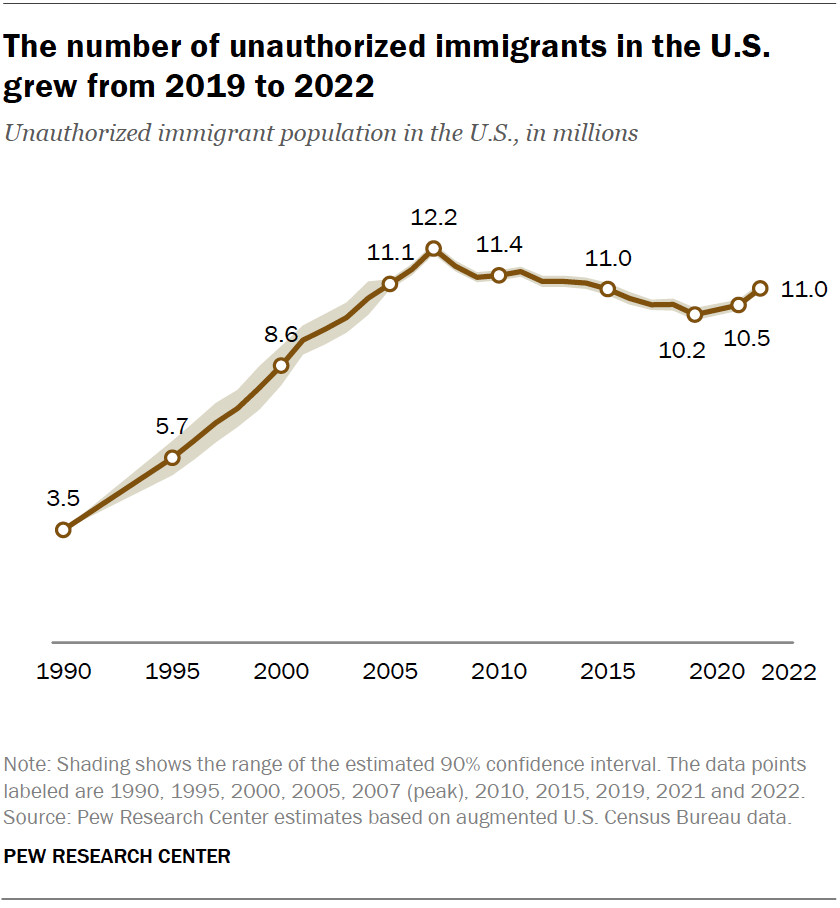 Line chart showing that the number of unauthorized immigrants in the U.S. grew from 2019 to 2022.
Line chart showing that the number of unauthorized immigrants in the U.S. grew from 2019 to 2022.
Unauthorized immigration is a multifaceted issue influenced by economic, social, and political factors. While Mexico remains a significant country of origin for unauthorized immigrants in the U.S., the dynamics are continually evolving. By understanding the trends, demographics, and policies shaping this issue, we can better inform discussions and policies related to immigration.
21. How Does All Of This Relate To The LGBTQ+ Community?
Understanding immigration trends is also essential for supporting LGBTQ+ immigrants, who may face additional challenges. At gaymexico.net, we strive to provide resources and information to help LGBTQ+ individuals navigate these complexities.
22. Where Can I Find More Information About LGBTQ+ Resources In Mexico?
Gaymexico.net offers a wide range of resources for LGBTQ+ individuals interested in Mexico. Whether you’re looking for travel tips, community connections, or legal information, our site is here to help. Explore our guides to LGBTQ+-friendly destinations, events, and services in Mexico.
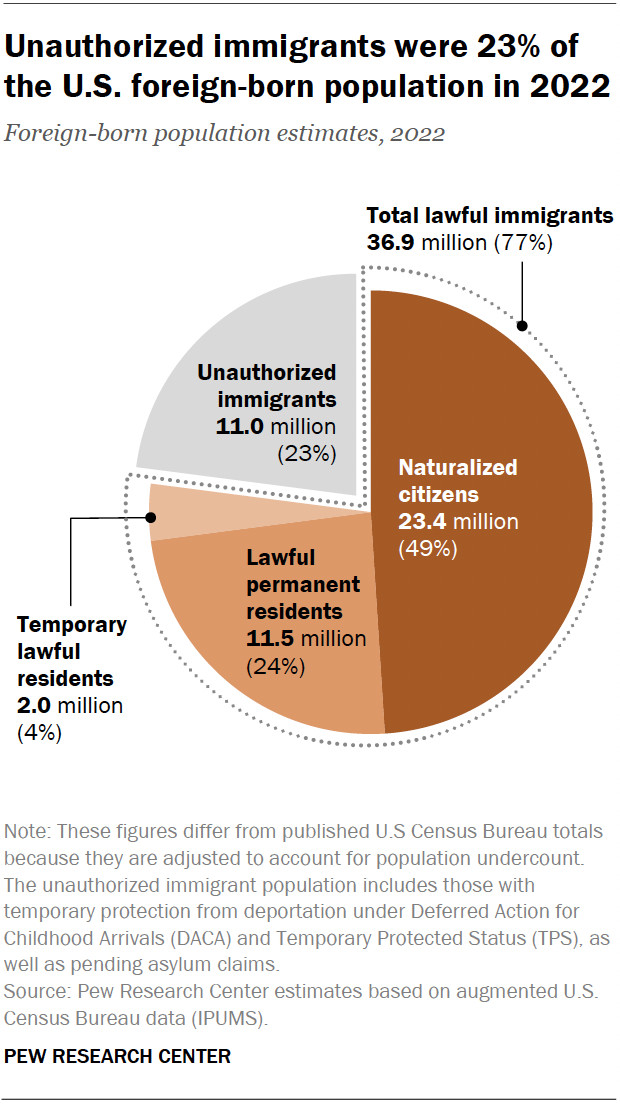 Pie chart showing that unauthorized immigrants were 23% of the U.S. foreign-born population in 2022.
Pie chart showing that unauthorized immigrants were 23% of the U.S. foreign-born population in 2022.
23. What Kind Of Support Can I Find On Gaymexico.Net?
On gaymexico.net, you can find:
- Detailed travel guides to LGBTQ+-friendly cities and regions in Mexico.
- Listings of gay bars, clubs, hotels, and events.
- News and information about LGBTQ+ rights and issues in Mexico.
- Resources for connecting with local LGBTQ+ communities.
- Tips for traveling safely and comfortably as an LGBTQ+ person in Mexico.
24. How Can I Stay Updated On The Latest News And Events For LGBTQ+ Travelers In Mexico?
Stay updated on the latest news and events for LGBTQ+ travelers in Mexico by visiting gaymexico.net regularly. You can also sign up for our newsletter and follow us on social media for the most current information.
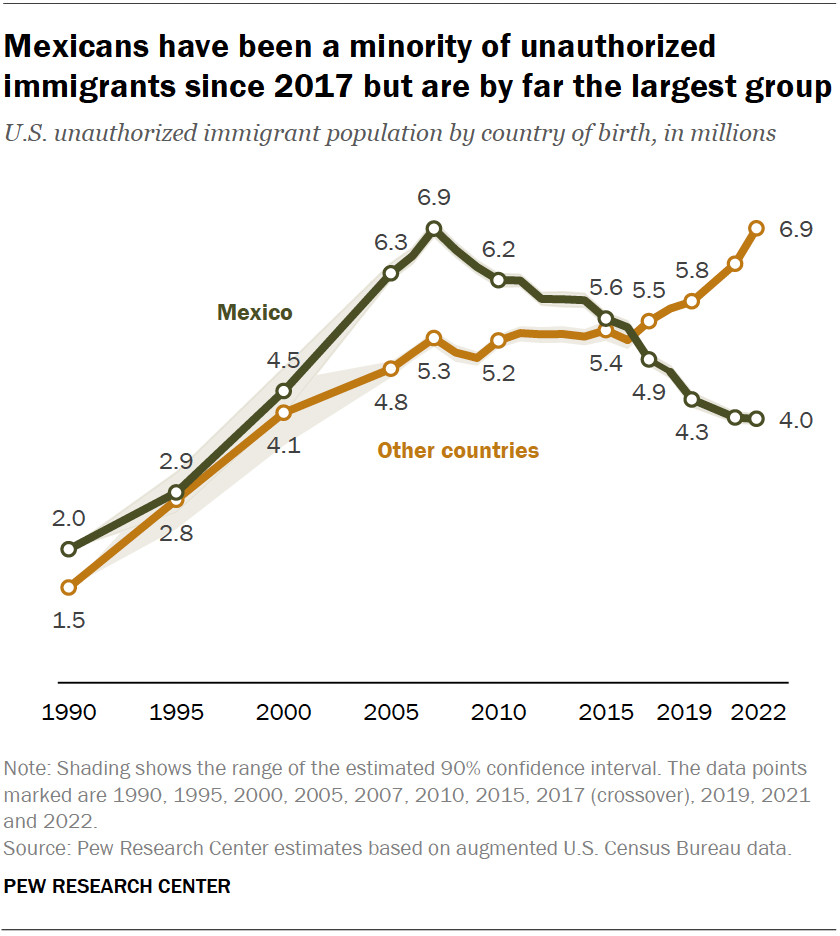 Line chart showing that Mexicans have been a minority of unauthorized immigrants since 2017 but are by far the largest group.
Line chart showing that Mexicans have been a minority of unauthorized immigrants since 2017 but are by far the largest group.
25. How Can Gaymexico.Net Help Me Plan My Trip To Mexico?
Gaymexico.net can help you plan your trip to Mexico by providing:
- Recommendations for LGBTQ+-friendly accommodations.
- Suggestions for must-see attractions and activities.
- Information on local customs and etiquette.
- Advice on transportation and safety.
- Tips for making the most of your travel experience.
26. Where Can I Find Information About LGBTQ+ Friendly Destinations In Mexico?
You can find information about LGBTQ+-friendly destinations in Mexico on gaymexico.net. We highlight popular cities and regions such as Puerto Vallarta, Mexico City, and Cancun, providing details on their LGBTQ+ scenes, attractions, and accommodations.
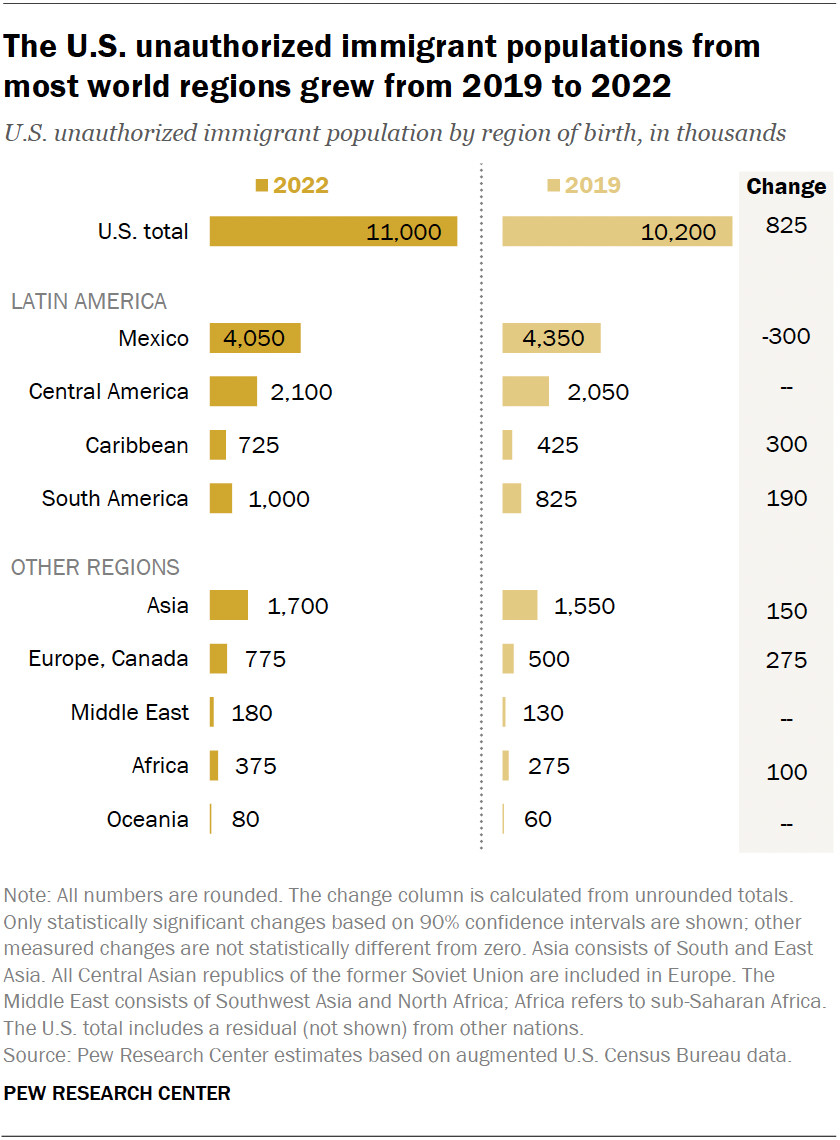 Bar chart showing that the U.S. unauthorized immigrant populations from most world regions grew from 2019 to 2022.
Bar chart showing that the U.S. unauthorized immigrant populations from most world regions grew from 2019 to 2022.
27. What Are Some Popular LGBTQ+ Events In Mexico?
Some popular LGBTQ+ events in Mexico include:
- Puerto Vallarta Pride: A week-long celebration featuring parades, parties, and cultural events.
- Mexico City Pride: One of the largest Pride celebrations in Latin America.
- Cancun Pride: A growing event with a focus on beach parties and entertainment.
- Guadalajara Pride: A vibrant celebration with a strong emphasis on community and activism.
28. How Can I Connect With The LGBTQ+ Community In Mexico?
You can connect with the LGBTQ+ community in Mexico through gaymexico.net. We provide links to local organizations, community centers, and social groups. You can also find information about LGBTQ+ events and gatherings where you can meet and connect with others.
29. What Should I Know About Safety When Traveling As An LGBTQ+ Person In Mexico?
When traveling as an LGBTQ+ person in Mexico, it’s important to be aware of local customs and attitudes. While major cities are generally accepting, attitudes may vary in more rural areas. It’s advisable to:
- Research the local LGBTQ+ scene and identify safe spaces.
- Be discreet in public displays of affection.
- Stay informed about local laws and regulations.
- Trust your instincts and avoid situations that make you feel uncomfortable.
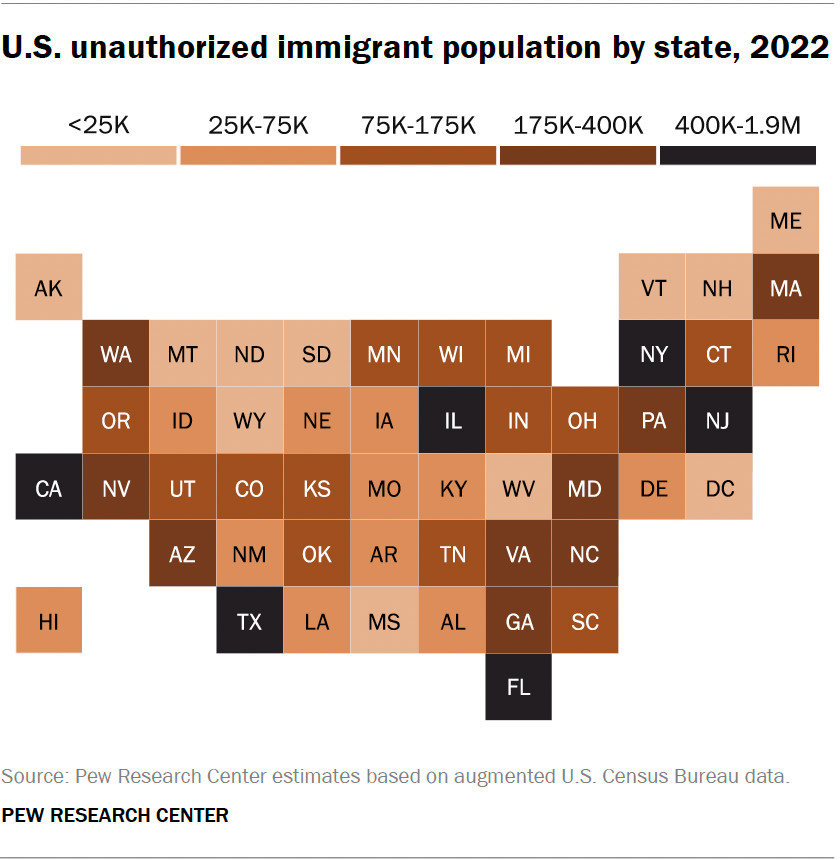 Heat map showing the U.S. unauthorized immigrant population by state, 2022.
Heat map showing the U.S. unauthorized immigrant population by state, 2022.
30. What Legal Rights Do LGBTQ+ Individuals Have In Mexico?
LGBTQ+ individuals in Mexico have made significant strides in legal rights. Same-sex marriage is legal throughout the country, and there are protections against discrimination based on sexual orientation and gender identity. However, awareness and enforcement of these rights may vary across different regions.
31. How Does Gaymexico.Net Support LGBTQ+ Rights In Mexico?
Gaymexico.net supports LGBTQ+ rights in Mexico by:
- Providing accurate and up-to-date information about LGBTQ+ issues.
- Promoting LGBTQ+-friendly businesses and organizations.
- Raising awareness about LGBTQ+ rights and equality.
- Offering a platform for community voices and stories.
32. How Does Gaymexico.Net Ensure The Accuracy Of Its Information?
Gaymexico.net ensures the accuracy of its information by:
- Relying on reputable sources and data, such as government reports, academic studies, and non-profit organizations.
- Regularly updating content to reflect the latest developments.
- Consulting with experts and community leaders to ensure accuracy and sensitivity.
- Encouraging feedback from our readers and community members to correct any errors or omissions.
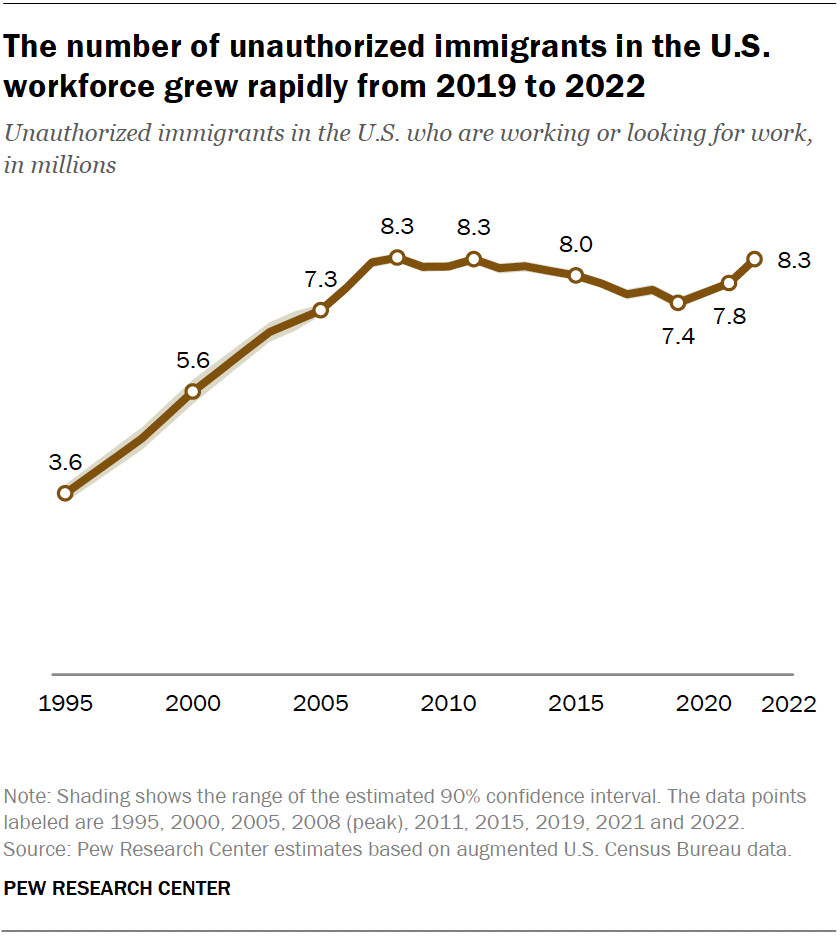 Line chart showing the number of unauthorized immigrants in the U.S. workforce grew rapidly from 2019 to 2022.
Line chart showing the number of unauthorized immigrants in the U.S. workforce grew rapidly from 2019 to 2022.
33. What Resources Are Available For LGBTQ+ Immigrants From Mexico In The US?
LGBTQ+ immigrants from Mexico in the U.S. can find support from various organizations that offer legal assistance, mental health services, and community support. Some of these resources include:
- Immigration Equality: Provides legal services to LGBTQ+ immigrants.
- The Trevor Project: Offers crisis intervention and suicide prevention services for LGBTQ+ youth.
- Local LGBTQ+ Community Centers: Provide a range of services and support groups.
34. What Are The Main Challenges Faced By LGBTQ+ Immigrants?
LGBTQ+ immigrants often face a combination of challenges related to their immigration status and their sexual orientation or gender identity. These challenges may include:
- Fear of deportation.
- Discrimination and stigma.
- Language barriers.
- Lack of access to healthcare and social services.
- Difficulty navigating complex legal systems.
35. How Can I Contribute To Gaymexico.Net?
You can contribute to gaymexico.net by:
- Sharing your travel experiences and stories.
- Providing feedback on our content.
- Suggesting new topics or resources.
- Volunteering your time or skills.
- Supporting our mission through donations or sponsorships.
36. How Does Gaymexico.Net Promote LGBTQ+ Tourism In Mexico?
Gaymexico.net promotes LGBTQ+ tourism in Mexico by:
- Showcasing LGBTQ+-friendly destinations, accommodations, and events.
- Providing practical tips and advice for LGBTQ+ travelers.
- Highlighting the rich cultural and historical contributions of LGBTQ+ people in Mexico.
- Encouraging responsible and respectful tourism practices.
37. What Are Some Common Myths About Unauthorized Immigration?
Some common myths about unauthorized immigration include:
- Unauthorized immigrants take jobs away from U.S. citizens.
- Unauthorized immigrants are a drain on the economy.
- Unauthorized immigrants commit more crimes than U.S. citizens.
- Unauthorized immigrants do not pay taxes.
These myths are often based on misinformation or incomplete data and do not reflect the complex realities of immigration.
38. How Can I Advocate For More Just Immigration Policies?
You can advocate for more just immigration policies by:
- Educating yourself and others about immigration issues.
- Contacting your elected officials to express your views.
- Supporting organizations that advocate for immigrant rights.
- Participating in peaceful protests and demonstrations.
- Voting for candidates who support fair and humane immigration policies.
For additional information and resources, please visit gaymexico.net.
Address: 3255 Wilshire Blvd, Los Angeles, CA 90010, United States
Phone: +1 (213) 380-2177
Website: gaymexico.net.
Discover LGBTQ+-friendly destinations, events, and community resources on gaymexico.net. Plan your safe and memorable trip to Mexico with our detailed guides and travel tips. Connect with the vibrant LGBTQ+ community in Mexico and explore the rich culture and history. Visit gaymexico.net today and start your adventure!